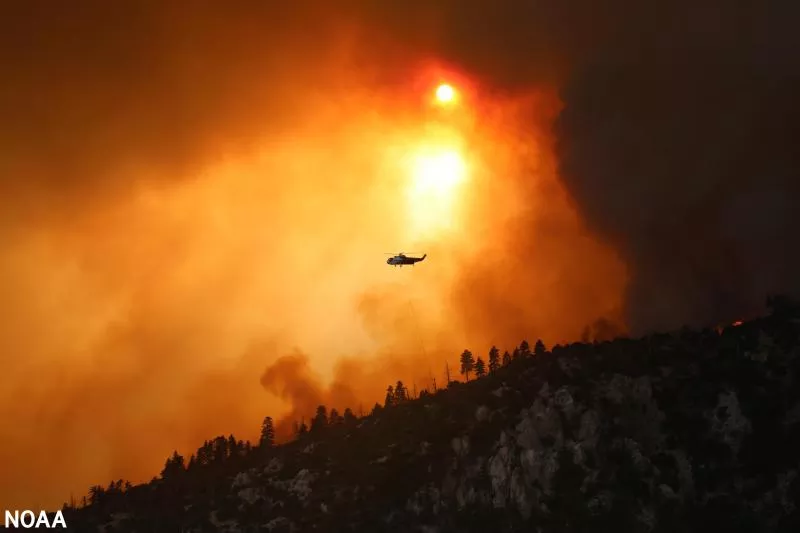Contact: John Bateman, john.jones-bateman@noaa.gov, 202-424-0929
Greenhouse gases and global sea levels both reached record highs in 2020—as the planet sweltered in a near-record warm year—according to the 31st annual State of the Climate report.

This international annual review of the world’s climate, led by scientists from NOAA’s National Centers for Environmental Information and published by the Bulletin of the American Meteorological Society, is based on contributions from more than 530 scientists in over 60 countries. It provides the most comprehensive update on 2020’s global climate indicators, notable weather events and other data collected by environmental monitoring stations and instruments located on land, water, ice, and in space.
Notable findings from the international report include:
- Earth’s greenhouse gases were the highest on record. The major atmospheric greenhouse gas concentrations, including carbon dioxide (CO2), methane (CH4) and nitrous oxide (N20), rose to a new record high during 2020. Despite a global pandemic that slowed economic activity around the world, the global annual average atmospheric CO2 concentration was 412.5 parts per million (ppm). This was 2.5 ppm greater than 2019 amounts, and was the highest ever measured in both the modern 62-year record as well as in ice core records dating back as far as 800,000 years. The annual average atmospheric methane concentration was also the highest on record, and the year-over-year increase of 14.8 parts per billion was the highest since measurements began.
- Global sea level was the highest on record. For the ninth consecutive year, global average sea level rose to a new record high and was about 3.6 inches (91.3 mm) higher than the 1993 average—the year that marks the beginning of the satellite measurement record. Global sea level is rising at an average rate of 1.2 inches (30 mm) per decade due to changes in climate, primarily warming oceans and the melting of glaciers and ice sheets.
- Earth’s warming trend continued. Annual global surface temperatures were 0.97–1.12 degrees F (0.54–0.62 of a degree C) above the 1981–2010 average, depending upon the dataset used. This places 2020 among the three-warmest years since records began in the mid- to late 1800s, and the warmest year on record without an El Nino. The last seven years (2014–20) were the seven warmest years on record, and the global average surface temperature has increased at an average rate of 0.14 of a degree F (0.08 of a degree C) per decade since the start of the record.
- Extreme warmth was felt at both poles. The 2020 mean air temperature for the Arctic land areas was the highest in the 121-year record, at 3.8 degrees F (2.1 degrees C) above the 1981–2010 average. This was the seventh straight year with an annual temperature more than 1 degree C higher than the 1981–2010 average. In Antarctica, extreme warmth was notable during its summer season. On February 6, 2020, Esperanza Station reached 64.9 degrees F (18.3 degrees C), the highest temperature ever recorded on the continent, surpassing the previous record of 62.9 degrees F (17.2 degrees C) set in 2015.
- Sea-surface temperatures were near-record high. The globally averaged 2020 sea surface temperature was the third highest on record, surpassed only by 2016 and 2019, both of which were associated with El Niños.
- Tropical cyclone activity was well above average. There were 102 named tropical storms during the Northern and Southern Hemisphere storm seasons, well above the 1981–2010 average of 85. Three tropical cyclones reached Saffir–Simpson scale Category 5 intensity. The North Atlantic hurricane basin recorded a record 30 named storms, seven of which became major (Category 3 or higher) hurricanes. In the western North Pacific, Super Typhoon Goni was the strongest tropical cyclone to make landfall in the historical record and led to the evacuation of almost 1 million people in the Philippines. Very Severe Cyclonic Storm Gati, which formed in the Arabian Sea, made landfall over Somalia—the first storm of such intensity to do so.
The State of the Climate report in a peer-reviewed series published annually as a special supplement to the Bulletin of the American Meteorological Society. The journal makes the full report openly available online, here. NCEI’s high-level overview report is also available online, here.